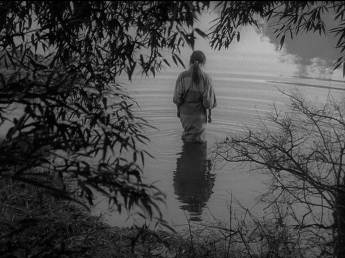This post constitutes the first of three about the genesis and implications of Joseph Cornell's Rose Hobart. [Part Two]. [Part Three].
On 21 June 1930, Universal Pictures announced twenty forthcoming films in its Universal Weekly trade paper, among them an unassuming jungle thriller called Ourang:
A startling dramatic romance filmed in the unexplored wilds of Borneo. Unique with almost unbelievable thrills and overflowing with virgin jungle color. The picture tells an absorbing tale of love and sacrifice in which a white derelict and a native girl find the only road to happiness stemming the stampede of the fierce ourangutans [sic]. Filmed by an expedition headed by Harry Garson.
Universal never completed, let alone released, Ourang. The demise of the project is unrecorded, but Garson incorporated most of the Universal footage into his subsequent feature The Beast of Borneo, issued in 1934 by his ad hoc road show company Far East Productions, Inc. By the time The Beast of Borneo was taken off the shelf, Universal had already recycled Garson’s Ourang footage for its 1931 Rose Hobart vehicle called (fittingly) East of Borneo.
Despite an aberrational sensation like All Quiet on the Western Front, Universal was a minor studio at the dawn of sound. Its assets hovered at $15.5 million in 1931—ahead of Columbia’s $6.35 million, but far, far behind the $173 million of Fox, the $213 million of Warner Brothers, and the $306 million of Paramount. East of Borneo was a cheap picture for a cheap studio, shot in four weeks by director George Melford.
Melford had been directing films since 1911. By the early thirties, the best gig he could find was Paul Kohner’s unit at Universal. Kohner headed the studio’s Spanish language unit—a truly marginal little department that turned out full Spanish language versions of the bigger studio properties (shot after hours on the same sets as the English versions, but with entirely different casts and crews) before the studios settled on dubbing as its standard for distributing their fare internationally—and hired Melford to direct a few features, despite the latter having no knowledge of the language. Given their working conditions, Melford and Kohner ground out a remarkable product—including their 1931 Spanish version of Tod Browning’s Dracula, by common consensus superior to the English version in every technical respect but not screened outside of Latin American cinemas for decades. Given the thriftiness of the unit, the trade buzz on East of Borneo—namely that the shoot was “begun in Sumatra, Shanghai, and the Far East by a sound-equipped expedition”—is rather difficult to swallow, unless read as an oblique reference to the Ourang expedition. East of Borneo, despite its English soundtrack, is every bit as threadbare as Dracula; Melford even recycles that film’s leading lady, Lupita Tovar, in a smaller role (though East of Borneo exploits Miss Tovar’s cleavage with aplomb equal to that of Dracula).
East of Borneo opened at the RKO Mayfair in New York on 25 September 1931, playing on the top half of a double bill with Murnau’s even more exotic Tabu (recently reduced to “popular prices”). The New York Times noted that East of Borneo ‘has its full quota, in fact a plethora, of jungle thrills.’ The Times’ Mordaunt Hall (clearly not the target audience for the film) admits at the end of his review that amid the amusing but juvenile pleasures of the jungle spectacle one finds ‘Miss Hobart ... serv[ing] the picture in her usual intelligent fashion.’ Variety’s review, published four days later, opened this way:
Sensational jungle and animal story loaded with thrill and natural for the neighborhood trade, even if it is pretty naive in treatment for the deluxers. For the class spots, however, it is promising for a week. Picture that ought to be great in the right places and moderately strong anywhere except blue-stocking clienteles.
Variety, too, singled out Hobart, noting she “plays a stilted role with the maximum of plausibility, and is even more than ever suggestive of Norma Shearer.” Another trade review, published as a preview in the 23 August issue of Film Daily, was more enthusiastic, calling East of Borneo “a colorful Oriental jungle meller that has practically everything ... it pours in everything of showmanship with prodigal profusion.” Photoplay wrote that East of Borneo was “a splendidly photographed thrill-story … exciting enough and beautiful enough to satisfy theater-goers with adequate work by Charles Bickford, Rose Hobart, and Georges Renavent.” neglected the matter of Hobart’s performance, they rated the direction “excellent” and the photography “the best”—the highest accolades Film Daily accorded to any of that week’s eight previews. Photoplay wrote that East of Borneo was “a splendidly photographed thrill-story … exciting enough and beautiful enough to satisfy theater-goers with adequate work by Charles Bickford, Rose Hobart, and Georges Renavent."
Universal touted the early success of East of Borneo with a subsequent ad in Film Daily (“universal gave rko a smash picture[.] rko gave it a smash ad campaign[;] a smash lobby ... a smash 24-sheet campaign[;] a smash exploitation resulting in smash business at rko’s mayfair), but the picture was not a sustained success: in the 1932 Film Daily Yearbook, Universal’s ad read, “The company that gave you frankenstein and strictly dishonorable takes great pride in calling your attention to this imposing list of hits,” followed by two columns of twenty-three titles—East of Borneo buried in nineteenth place. The next page of Universal’s big ad buy featured a full-page publicity pic of studio head Carl Laemmle, Jr., followed by one of Strictly Dishonorable director John M. Stahl. Similar treatment was never accorded to marginal Melford and East of Borneo failed to crack the top fifty of the Film Daily Yearbook critics’ poll. So after a circuit of cheap runs, the picture built from the scraps of the never-completed Ourang disappeared from public view. That is, until December 1936 when Joseph Cornell would take the scraps of East of Borneo and fashion his perpetually incomplete masterpiece Rose Hobart.

No comments:
Post a Comment